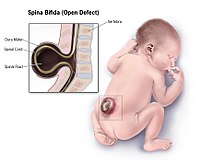
Photo from wikipedia
Neural tube defects (NTDs) are birth defects that result from errors in the process of neurulation during development. The most frequent forms include anencephaly, which is fatal and involves damage… Click to show full abstract
Neural tube defects (NTDs) are birth defects that result from errors in the process of neurulation during development. The most frequent forms include anencephaly, which is fatal and involves damage to the developing brain, and spina bifida, which is associated with increased mortality and involves damage to the developing spine and spinal cord. The posterior spinal defects (e.g., spina bifida) can result in paralysis and sensation loss of the lower limbs, ambulation difficulties, bowel and bladder dysfunction, cognitive deficits, and associated infections and treatment-related complications. Mandatory fortification of the food supply with folic acid in the United States and elsewhere has resulted in decreases in NTD rates (De Wals et al., 2008; Poletta et al., 2018; Williams et al., 2015), but the prevalence is still high (~2 per 1,000 live births, globally; Blencowe, Kancherla, Moorthie, Darlison, & Modell, 2018). Major ongoing research initiatives include studies aimed at identifying genetic risk factors for NTDs, understanding the mechanisms that explain epidemiologic associations (e.g., with maternal diabetes, Hispanic ethnicity, and body mass index), and understanding the determinants and modifiers of spina bifida morbidity and mortality. The International Conference on Neural Tube Defects series began in 1999 and serves as a biannual, multidisciplinary venue for bringing together basic science, clinical, and epidemiologic researchers around the world working toward NTD prevention and treatment. The 10th International Conference on Neural Tube Defects was held October 1, 2017 in Austin, TX. This Special Issue of Birth Defects Research highlights proceedings of the meeting. The conferencewas attended by 103 people, representing four continents (North America, South America, Europe, and Asia). A broad range of experience and scientific inquiry was represented among 49 oral and 17 poster presentations, including work related to embryology and developmental biology, physical sciences, maternal nutrition, environmental exposures, animal and human genetics, epidemiology, global health, and clinical research. The opening invited lecture was delivered by Brian O'Roak, who spoke about how genomic approaches that have been applied to autism researchmight informNTD research. The Marcy Speer Memorial Awards are awarded at the conference to trainees at the predoctoral and postdoctoral levels with exceptional platform presentations. This award honors Marcy Speer (1959–2007), a distinguished statistical geneticist and genetic epidemiologist who co-founded the inaugural International Conference on Neural Tube Defects and was passionate about mentoring and training the future generations of NTD researchers. This year, the awardee for the predoctoral category was Micah Ross, Brigham Young University, for the presentation “Measuring Gluthathione Redox Potential as a Tool in Understanding the Mechanism of Failed NTC in Response to Developmental Toxicants.” The awardees for the postdoctoral category were Amanda Baumholtz, McGill University, for the presentation “Claudins Have a Conserved Role in Neural Tube Closure: Functional Analysis of Cldn Variants” and Jitao Zhang, University of Maryland, for the presentation “Optical Quantification of the Stiffness of Embryonic Tissue with Brillouin Microscopy.” For this issue of Birth Defects Research, we invited attendees to submit manuscripts related to work that was presented at the meeting. The contribution of animal models to NTD research resounded throughout the meeting. This included work on neural tube formation and development involving planar cell polarity, intracellular and intercellular signaling, epigenetic, post-translational, oxidative, and biomechanical changes. This work is highlighted in an article in this issue by Zhang et al. related to the use of Brillouin microscopy and optical coherence tomography to measure tissue biomechanics during neural tube closure, and the report by Lin et al. on the effects of valproic acid and its analog, valnoctamide, on mouse neural tube development. Further, the study by Kappen et al. characterized diabetic induced neural-mesodermal protrusions that often precede diabetic-induced NTDs in mouse embryos. The papers in this issue also feature a wide spectrum of work involving or more directly related to humans. Shumate et al. used a population-based birth defect registry to evaluate how neighborhood-level measures of advantage and disadvantage influence risk for spina bifida. Themes related to the impact of NTDs in developing countries are highlighted in reports on risk related to maternal nutrient intake in Bangladesh by Lee et al., and on the projected impact of folic acid fortification on the prevention of NTD-related mortality in developing countries by Kancherla et al. An article from Castillo et al. reviews initial findings from the National Spina Bifida Patient Registry, a national effort to Received: 1 May 2019 Accepted: 6 May 2019
Journal Title: Birth Defects Research
Year Published: 2019
Link to full text (if available)
Share on Social Media: Sign Up to like & get
recommendations!